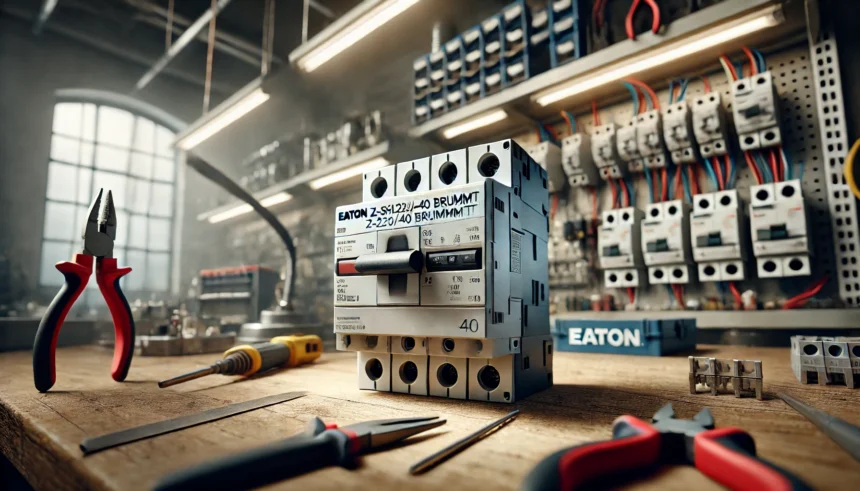The Eaton Z-SCH230/40-40 brummt is a well-known electrical contactor used for switching and controlling electrical loads. It is widely applied in industrial and residential systems where reliable electrical switching is necessary. This contactor operates with a control voltage of 230V AC and is designed to handle up to 40A of current.
However, some users report a buzzing or humming noise from the device. This article will explain its features, common causes of the noise, and troubleshooting methods to fix the problem
Understanding the Eaton Z-SCH230/40-40 Contactor
An electrically operated switch used to switch power circuits is called a contactor. Unlike traditional relays, contactors can handle higher current loads and are designed for frequent switching. The Eaton Z-SCH230/40-40 is widely used in lighting, heating, and motor control systems.
Key Features
- Rated for 40A Load: Designed to handle medium to large electrical loads.
- Control Voltage of 230V AC: Ensures compatibility with standard electrical systems.
- High Switching Endurance: Built for frequent switching cycles, making it reliable over time.
- Compact DIN Rail Mounting: Allows easy installation in electrical panels.
- Low Switching Noise: Engineered for quiet operation under normal conditions.
- Durable Internal Contacts: Designed to reduce electrical arcing and improve lifespan.
Applications of the Z-SCH230/40-40
- Industrial machinery: Controls motors and large equipment.
- Lighting systems: Used in commercial and street lighting automation.
- Heating systems: Manages electrical heating devices.
- Renewable energy systems: Works in solar or battery management applications.
Why Does the Eaton Z-SCH230/40-40 Make a Buzzing or Humming Noise?
A well-functioning contactor should operate with minimal noise. However, if you hear a buzzing or humming sound, this could indicate a problem. Below are the main reasons:
Common Causes of Buzzing Noise (Brummt)
Overloading the Contactor
If the connected load exceeds the 40A limit, the contactor might struggle to operate smoothly.
Overloading can cause excessive vibrations in the contactor coil, resulting in a buzzing sound.
Electrical Interference
Electrical noise from other nearby devices can interfere with the magnetic coil inside the contactor.
This may cause vibrations or an unstable magnetic field, leading to a humming noise.
Loose Electrical Connections
Loose wires at the input or output terminals may cause small sparks or vibrations, resulting in a buzzing sound.
Poorly secured screws or DIN rail mounting can also contribute to this issue.
Control Voltage Issues
The Z-SCH230/40-40 operates at 230V AC control voltage. If the supply voltage fluctuates or drops, the magnetic coil may not receive enough power to function properly.
Low or unstable voltage can cause the coil to vibrate, leading to a humming noise.
Worn Out or Dirty Components
Over time, the internal contacts and coil may wear out due to frequent switching.
Accumulated dirt or corrosion on the contacts may lead to improper operation, causing electrical noise.
Environmental Factors
Extreme temperatures, moisture, or dust inside the panel can affect the contactor’s function.
A humid or dirty environment may cause rust or debris buildup inside the device, leading to buzzing sounds.
How to Fix a Buzzing Eaton Z-SCH230/40-40 Contactor
If your contactor is making an unusual noise, follow these troubleshooting steps to diagnose and fix the problem.
Step 1: Check the Electrical Load
- Verify that the connected devices do not exceed the 40A limit.
- If needed, replace the contactor with a higher-rated model if the load is too high.
Step 2: Inspect Wiring and Connections
- Turn off power before checking the wiring.
- Tighten all connections at the input, output, and control voltage terminals.
- Ensure the device is properly mounted on the DIN rail and not vibrating due to loose installation.
Step 3: Measure the Control Voltage
- Use a multimeter to check if the control voltage is within the range of 230V AC.
- If the voltage is too low or fluctuates, check your power supply and stabilizer settings.
Step 4: Clean or Replace Worn Components
- Open the contactor (if safe and possible) and check for any carbon deposits, dust, or corrosion on the contacts.
- If contacts are worn out, consider replacing the contactor.
Step 5: Check for External Electrical Interference
- Identify if other high-power devices nearby are causing electromagnetic interference.
- Try moving the contactor away from noisy electrical equipment or using shielding techniques.
Step 6: Consider Environmental Factors
- Ensure the contactor is not exposed to excessive heat, moisture, or dust.
- If necessary, use an enclosure to protect it from environmental damage.
Preventative Maintenance Tips
To avoid future issues, follow these maintenance steps:
Regular Inspections
- Periodically check the wiring connections and tighten any loose screws.
- Look for any signs of corrosion or overheating inside the electrical panel.
Keep the Contactors Clean
- Remove dust and debris using compressed air or a dry cloth.
- Avoid using liquids or aggressive cleaning agents, as these could damage the electrical components.
Use Properly Sized Contactors
- If you plan to expand your system, ensure your contactor is correctly rated for the increased load.
- Using an undersized contactor can cause overheating and buzzing.
Control Temperature and Humidity
- Keep the panel well-ventilated to prevent overheating.
- If operating in a high-moisture environment, use sealed enclosures to protect electrical components.
When to Call a Professional
If you have tried all the troubleshooting steps but the buzzing noise persists, it might be time to seek professional help.
- If the contactor frequently trips or fails to switch properly → This could indicate serious electrical issues.
- If there is a burning smell or visible damage → The device may be overheating or have damaged components.
- If voltage fluctuations are frequent → You may need a professional electrician to assess your power supply.
Conclusion
The Eaton Z-SCH230/40-40 brummt is a reliable and widely used contactor for controlling electrical loads. However, buzzing or humming sounds can indicate issues such as overloading, loose connections, voltage fluctuations, or worn components.
By following proper troubleshooting and maintenance procedures, users can resolve most buzzing issues and ensure a long service life for the contactor. If problems persist, consulting a professional is recommended to prevent electrical failures and ensure safe operation.
FAQs
Why is my Eaton Z-SCH230/40-40 making a buzzing sound?
This usually happens due to loose wiring, voltage fluctuations, or overloading beyond 40A. Check and tighten connections.
Can I use Eaton Z-SCH230/40-40 for motor control?
Yes, it can control small to medium motors, but ensure the motor’s startup current does not exceed the 40A rating.
How do I fix a contactor that won’t switch on?
Check if the control voltage (230V AC) is present, and verify that the coil is not damaged or burnt out.
Does a humming contactor indicate failure?
Not always, but persistent humming could signal wear, improper mounting, or a coil nearing failure.
What is the lifespan of an Eaton Z-SCH230/40-40 contactor?
It depends on usage, but with proper maintenance and correct load handling, it can last several years.









